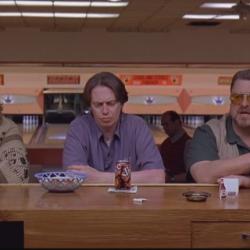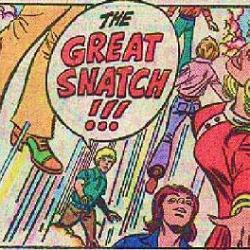Left Behind II: Tribulation Force, Part 3
“When your fiancé comes, he can stay here too,” Cam-Cam tells flirty not-Alice as she settles in to his apartment, and hundreds of conservative youth pastors sigh in relief as the movie crosses back into mostly acceptable territory.
It’s clear now how the movie’s version of the book’s romantic-confusion subplot will unfold, with Chloe jumping to the wrong conclusion about Cam-Cam and not-Alice and bursting into silly girl-tears. It’s just so much more romantic when you make them cry.
The phone rings — this is a Left Behind movie, after all — and it’s Steve Plank, politely reminding Buck to schedule an appointment with Planetary Potentate Carpathia. The filmmakers try their hardest to make this seem spooky and menacing, since Buck never gave Steve his home number. In the first movie, we saw Nicolae divvy up the world among 10 princes, murder two people in cold blood, and then brainwash a room filled with witnesses, so I’m not sure that tracking down an unlisted phone number really adds much to our sense of him as a powerfully menacing evil presence.
(On the scale of Creepy Movie Phone Calls, I’d score calling an unlisted home number as about a 3, with “Because I want to know who I’m looking at” a 7, “It’s coming from inside the house!” an 8, and realizing the phone isn’t plugged in a 9. A 10, of course, would be any call from Sallie Mae.)
We cut back to Rayford standing in front of New Hope Village Church. It’s nighttime, but we don’t know if this is the same night or the next night. The church we see through the open door behind Rayford isn’t the same church we see once they get inside, which, in a way, is creepier than Steve’s phone call.
“Hey Chris,” Rayford says, greeting his co-pilot from the first movie. Movie-Rayford seems to have more friends than book-Rayford does.
Inside the church, the pews are neatly arranged and filled with curious visitors as Bruce Barnes stands up front ‘splaining to them all about Bible prophecy. Bruce says …
Wait a second. Rewind. Suddenly I’m remembering a scene from the segment we looked at last week. It was only about 30 seconds long and I failed to discuss it then. I think I had pushed it out of my brain because: A) it makes very little sense, and B) it seemed to be included only to reinforce to us that Chloe/women is/are utterly useless.
That scene seemed to take place in New Hope’s sanctuary, but the pews had been removed, replaced with cots and floor-lamps scattered about the room. Wounded people of indeterminate origin and identity lay in the cots, with Bruce and some other people puttering about reading Bibles and/or administering first aid.
It was the sort of scene one would expect to see in the chaotic immediate aftermath of a major earthquake or similar disaster, but what that disaster was here in this movie was never explained. We know it wasn’t the Rapture and the crashes and calamities that came with that, because that was more than a week ago in our story and we’ve seen dozens of scenes showing us that life is back to normal from that. (Completely back to normal, strangely, with the missing children now regarded as old news.)
So I guess this church-based little MASH unit is in response to the random violence and criminality that the movie erratically suggests characterizes the post-Rapture world. And seen from one angle, that’s a nice corrective to what we read in the book. It shows Bruce and the other new believers at New Hope putting their faith into action in a way that none of the believers in the book ever do. And it provides Bruce and Chloe with more of an active role than they have in the book, where they both spend months and months locked away studying Bible prophecy lore that any semi-literate person could master in a day or two.
But how are we to explain the way this emergency field hospital suddenly appears in the church at sundown before disappearing the next morning? Where are all those patients now? Did Bruce and those firefighters finally come to their senses and move this emergency overflow clinic to the newly available elementary school? Or have that poor burn victim and the others been stashed away in some quiet Sunday school room so that Bruce can use the sanctuary for his prophecy lecture the next night?
And at a more basic level, the existence of those firefighters contradicts the whole premise of the scene. The idea of all that post-Rapture criminality and violence is that once the salt and light of real, true Christians are removed from this world, everyone left behind will be irredeemably wicked. As it was in the days of Noah, everyone will do what is right in their own eyes, dogs and cats sleeping together, etc.
So explain those firefighters. They weren’t raptured, so we have to count them among the wicked. Yet they don’t seem wicked. They seem like, well, like firefighters — doing exhausting, back-breaking, dangerous work for paychecks that barely keep them in the middle class. That would seem to indicate the possibility of altruistic and virtuous behavior among the unregenerate unsaved — and if that’s the case, then what’s with all the sirens and chaos and Escape From New York streetscenes?
Anyway, back to the present. Bruce Barnes is speaking:
Every person in this room has lost someone. A mother, brother, wife, friend. Ask yourselves this question: Did all of these people have anything in common? Yes. Two things. Either they had decided to follow Christ. Or they were too young to have made that decision in their lives already.
So I’ve got good news for you tonight. We lost our loved ones because of the Rapture. The Bible told us it was coming, but anyone who believed in Jesus Christ is in heaven right now with God. What’s left for us is a second chance.
And that concludes the comforting-the-bereaved portion of Bruce’s lecture and Bruce’s ministry. Your kids are in Heaven, let’s move on. We’ve got a prophecy check list to study and we don’t really have time for any more bother about our missing children, ‘kay?
Bruce starts to talk about the Tribulation and the Antichrist, projecting a map of Israel onto a large screen in the front of the sanctuary. This map clearly shows the actual nation of Israel as it currently exists — not the Greater Israel of the novels that Tim LaHaye insists must come to be in fulfillment of his prophecies, a vast area including most of what is now Lebanon and Jordan as well as parts of Egypt, Syria and Iraq. (The map also does not include Asia Minor, which is strange considering that Bruce intends to talk about the book of Revelation — a book expressly addressed to the churches in seven cities not on his map.)
Bruce explains that the Antichrist is on the rise — the first horseman of the Apocalypse. And because the Bible says he will ride forth “conquering and to conquer,” Bruce explains, we know that he will be a diplomat using diplomacy.
Chris sits impatiently, growing increasingly agitated before he finally gets up and walks out. Rayford and Buck follow him. Happily, so does the camera, meaning we’re not going to be stuck hearing the rest of Bruce’s lecture.
The scene that follows will be familiar to anyone acquainted with Christian-brand movies. It’s the evangelism fantasy sequence.
Cam-Cam confronts Chris with his version of the process of salvation. If you’re expecting something similar to the gospel of the Gospels, or to the gospel laid out in Paul’s epistles, then the Gospel According to Cam-Cam may seem strange. Basically he presents an argument for the theory of substitutionary atonement. If he can convince Chris to concede and assent to this argument intellectually, then Chris will saved. If Chris does not intellectually assent to this theory of atonement, then he will be damned to Hell for an eternity of conscious torment.
Cam-Cam’s goal in this conversation, in other words, is to get Chris to admit that he’s an awful person who rightfully deserves to be despised by God.
The fantasy element here is in Chris’ lines. His response to every prompt from Cam-Cam is, implausibly, precisely the response that Cam-Cam’s scripted conversion formula anticipates and requires. Chris seems powerless to say anything other than what Cam-Cam wants and expects him to say. He is trapped by the inexorable logic of the script.
Pure fantasy. No human being has ever given the responses required by the script and the formula that Cam-Cam employs here. No real human has ever recited the lines Chris recites here, allowing the evangelist to finish the recitation and to follow every step of the script’s neat presentation of the good news of bloody ransom.
That’s what makes the evangelism fantasy scene frustrating and cruel for its intended audience. Many of them will do just what it encourages them to do — they will go out into the world and attempt to replay this scene and this conversation with real people who, being real people rather than the ventriloquist’s dummies of the fantasy, won’t follow the strange logic of the script. And when those attempts to replicate the fantasy go horribly awry, these would-be evangelists will feel it is their fault — that they did something wrong, that they garbled the words, or left something out, or didn’t pray hard enough beforehand. And they will wind up feeling guilty and ashamed that real life isn’t like the fantasy.
David Macniven has an impossible task in this scene in the role of Chris. Not only does he have to supply all the unnatural responses to Cam-Cam’s evangelistic spiel, but he has to show that Chris finds the logic of that spiel undeniable and compelling. And then — while showing us that he agrees with every word Cam-Cam says — he has to show us that he still chooses to reject it just because.
In our survey of the books, we’ve noted many scenes like this. The authors often assume that anyone who has heard the soterian gospel without immediately converting must be deliberately choosing to reject it despite, deep down, knowing it to be the truth. Here poor Macniven has to find some way of portraying that perverse rebellion, he has to embody it and try to make it appear like something a human might actually choose to do.
He fails. “I can’t accept that,” he says, reciting the line from the script and walking away as it instructs, for no apparent reason other than that these lines and stage directions were written in the script. It seems unnatural and inhuman, but I don’t blame Macniven. No actor could make that scene work.
Back in the church we see Bruce conduct an altar call. This one has a bit of a twist in keeping with the wheat-from-the-chaff theme of this story — most of the people in the church come forward to be saved, but the rest don’t stay seated in the pews, they get up and leave.
CCM artist Regie Hamm starts singing something mournfully earnest and we see Rayford walking the mean streets of post-Rapture suburban Chicago. Roving mobs of the godless, unregenerate, left-behind evildoers are …
Well, actually, they’re mostly holding candles, weeping, praying and comforting one another as they gather around makeshift shrines commemorating their lost loved ones. These are the people that Cam-Cam’s God finds unworthy, unholy and deserving of destruction unless they assent to the proper propositions and pray the magic words. I’m sure this scene wasn’t intended only to undermine everything Cam-Cam just said in his scripted argument with Chris, but that’s what it does here.
Rayford’s reverie is interrupted by a woman in white who asks him, “You lost someone too?” But then his cell phone rings with a literal call for help from Chris and we get a lingering close up on this woman as he rushes off. She’s listed in the credits as “angelic woman.” I have no idea what to make of that.
A note about content: The remainder of this scene involves discussion of suicide.
The only hint we have of what’s going on in the next scene is in the initial shot, where we see Chris’ left hand with his wedding ring. He’s spinning a handgun on the coffee table in front of him.
Yeah, it’s that scene. Distraught man with gun contemplates ending his own life. Our hero arrives to try to talk him out of it.
But apart from that hint of the wedding ring, the filmmakers haven’t suggested why Chris is threatening to kill himself. The last time we saw him he wasn’t distraught, just fed-up. We haven’t been given any reason to guess at what Chris is going through. In his conversation with Cam-Cam he was begrudgingly willing to stipulate his technical guilt in Calvinist terms, but Chris is clearly not a man wracked with guilt, shame or remorse. He’s not suffering from a medical infliction that would lead him to this, or suffering through an existential crisis of meaning.
So that just leaves us with that wedding ring and the guess that he must be suffering from grief over the loss of his family. That seemed to be the cause of this character’s parenthetical suicide in the first Left Behind novel — an act that book-Rayford could barely be bothered to notice. Book-Chris’ wife was killed in a post-Rapture car-crash. Viewers of this film have no reason to suspect that’s also true of movie-Chris, but if it is, then his grief here is understandable, as both Bruce and Cam-Cam just carefully explained to him that his wife is even now burning in the fires of Hell.
But if this is what Chris is supposed to be thinking here, then what was the point of having Cam-Cam and Rayford focus exclusively on Chris’ sinful unworthiness when trying to talk to him of salvationism? If someone has just lost his wife and kids, then it might make sense to try to convince him that God is still a good and loving God despite the apparently arbitrary injustice and cruelty of this world. But it doesn’t make any sense at all to think that the No. 1 thing you need to do is convince him that he has sinned and fallen short of the glory of God. That’s cruel and bewilderingly beside the point.
“I know what it’s like,” Rayford says, “I lost my wife and my son, everything, just like you.”
Ah, OK, so grief it is, then.
Rayford starts out well, by acknowledging the substance, gravity and enormity of Chris’ grief, but then things go a bit sideways. He picks up where Cam-Cam left off, not with counseling or comfort, but with apologetics — with an attempt to create a logical argument for the existence of God from which Chris might further extrapolate that life is meaningful.
I don’t think this is a wise or helpful approach. If I’m ever distraught and out on the ledge, please do not send Josh McDowell out to talk me down.
Rayford’s whole case for Earth is based on Heaven. I think that’s backwards. He tells movie-Chris that his wife is in Heaven — unlike book-Chris’ wife, she was apparently raptured. He convinces Chris of this by asking him if he can prove otherwise.
“If they’re not, then where are they? You tell me, where are they?” Rayford shouts. Then he segues into a weird variation of something like Pascal’s wager before, finally, getting Chris to give up the gun and accept Jesus. Or something.
I heard Angela Lansbury interviewed once, talking about the intimidating task of playing Gypsy Rose Lee after the role had been defined by the inimitable Ethel Merman. “If you can’t sing the song,” Lansbury said, “sing the scene.”
That’s what Brad Johnson does here as Rayford. His lines here don’t make any sense, but he speaks them with a passion that conveys the sense of what he ought to be saying. The scene would actually make more sense if Johnson were speaking in some language I don’t understand. I could then watch the scene and follow the emotional trajectory of the two actors and feel as though I understood everything I was seeing. It would make more sense that way than the way it seems here, in English, where I can understand the appallingly inept words Rayford is actually speaking.
It’s a terrible song, but Johnson does a good job of singing the scene.












